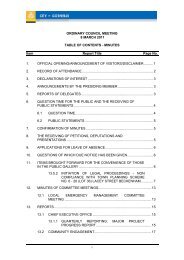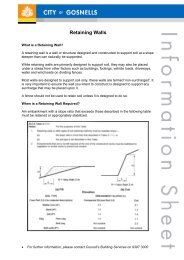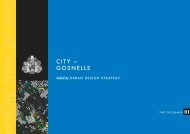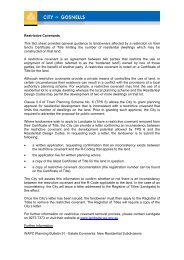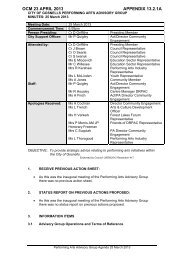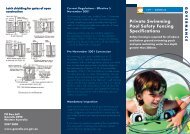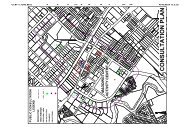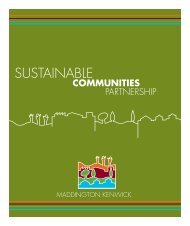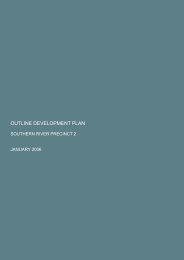Summary - City of Gosnells
Summary - City of Gosnells
Summary - City of Gosnells
Create successful ePaper yourself
Turn your PDF publications into a flip-book with our unique Google optimized e-Paper software.
Regional Setting 9Most <strong>of</strong> the rivers and creeks <strong>of</strong> the SCP (including Yule Brook and Bickley Brook) are heavily modified bythe deepening and straightening <strong>of</strong> existing channels and the construction <strong>of</strong> drains to increase conveyancecapacity and to lower superficial groundwater levels (Swan River Trust, 2009). The Yule Brook and BickleyBrook catchments in the MKSEA include a number <strong>of</strong> small creeks, but few <strong>of</strong> these have retained theirnatural form; most have been excavated and diverted to facilitate drainage (Figure 7). The area also has anumber <strong>of</strong> small-scale, discontinuous channel segments (that are evident in the stratigraphic sequences andvegetation <strong>of</strong> the area) that indicate the locations <strong>of</strong> natural surface drainage channels that in the past hadsimilar attributes to the currently active channel <strong>of</strong> Yule Brook (V & C Semeniuk Research Group, 2001).The Swan River Trust (2009) has prepared a Water Quality Improvement Plan (WQIP) for the Swan andCanning Rivers. The flow rates and nutrient levels <strong>of</strong> numerous watercourses (including Bickley Brook andYule Brook) that contribute to the Swan and Canning River system are regularly monitored (Swan RiverTrust, 2008a, 2008b). One <strong>of</strong> the main aims <strong>of</strong> the WQIP is ‘to set environmental flow objectives, protectwetlands and floodplains (mimic natural inundation and drying patterns) and to minimise the effects <strong>of</strong> damsand extraction <strong>of</strong> water on water quality’ (Swan River Trust, 2009).The environmental flow objectives for aquatic and riparian vegetation for watercourses on the SCP wereidentified in GHD (2008) and these are relevant to the MKSEA. These objectives were:• ‘Maintenance and restoration <strong>of</strong> wetland/riparian vegetation in winter-wet, pastured, floodplain regionsand along the periphery <strong>of</strong> drainage channels;• Inundation <strong>of</strong> wetland/riparian vegetation to restore and maintain these areas; and• Seasonal inundation <strong>of</strong> emergent and mid bank vegetation (for survival, germination and recruitment).’In the MKSEA there are some areas where deep and water-permeable Bassendean Sands overlie, or areemergent from, the Guildford Formation. These dunes and low ridges occur mainly in the southeast <strong>of</strong> theMKSEA, where they generally form localised perched water mounds. Rainwater infiltrates the BassendeanSands and is slowly discharged laterally (along the contacts <strong>of</strong> the dunes with the adjacent, largelyimpermeable, Guildford Formation clay layers) onto the adjacent palusplains. The hydrology <strong>of</strong> the smallscale,seasonally-waterlogged slopes (paluslopes) that are maintained by such seepages from low ridges inthe Greater Brixton Street Wetlands, and the artesian pressure heads in some aquifers associated with theBassendean Sands/Guildford Formation interfaces in this area, were described in V & C Semeniuk ResearchGroup (2001). These areas in the Greater Brixton Street Wetlands are the only examples <strong>of</strong> paluslopewetlands that have been described to date on the SCP. The general principles <strong>of</strong> paluslope formation areillustrated in Hill et al. (1996, Volume 2A, Figure 2.13).The boundaries between the Pinjarra Plain landscapes (that occur mainly in the northern and central area <strong>of</strong>the MKSEA) and the Bassendean Dunes landscapes (that occur mainly in the southeast <strong>of</strong> the MKSEA) are<strong>of</strong>ten subtle and irregular. These boundaries effectively divide the wetland landscapes from the uplandlandscapes. In simple terms, one <strong>of</strong> the major boundaries <strong>of</strong> this type in the MKSEA in the vicinity <strong>of</strong>Victoria Rd has been described as ‘a watershed’ (GHD, 2005). However, it is not simply the crest <strong>of</strong> a ridgethat sheds water uniformly down the surfaces <strong>of</strong> both <strong>of</strong> its slopes. This boundary is marked by a subtletopographical gradient but also complex stratigraphy and hydrology (where water recharge, storage anddischarge can be influenced by factors such as groundwater flow, seepage from perched aquifers, artesiansprings, and channelled surface flow). Thus an array <strong>of</strong> wetland types (including paluslopes, palusplains,floodplains, sumplands and damplands) has developed along this boundary. A number <strong>of</strong> small dams havealso been excavated along this boundary and this has further complicated the hydrological features <strong>of</strong> thearea. The boundary between the Bassendean Sands and the Pinjarra Plain in this area is also significant interms <strong>of</strong> biological values. The remnant native vegetation along this boundary is <strong>of</strong>ten atypical or uncommonin terms <strong>of</strong> other vegetation on the SCP and thus <strong>of</strong> high conservation significance and both the naturalwetlands and excavated dams in the area are significant habitats for waterbirds and probably other nativefauna. To achieve optimum environmental outcomes for the Greater Brixton Street Wetlands and theMKSEA, it is important that the Pinjarra Plain to Bassendean Dunes interfaces <strong>of</strong> the area are mappedaccurately at a fine scale. Decisions about development in the area (such as the determination <strong>of</strong> buffer zonesto protect the wetlands adjoining the Pinjarra Plain to Bassendean Dunes interfaces) should be based ondetailed field studies <strong>of</strong> topography, stratigraphy and hydrology that have been conducted over anTauss, C. and Weston, A.S. (2010). The flora, vegetation and wetlands <strong>of</strong> the Maddington-Kenwick Strategic Employment Area.A survey <strong>of</strong> the rural lands in the vicinity <strong>of</strong> the Greater Brixton Street Wetlands. Report to the <strong>City</strong> <strong>of</strong> <strong>Gosnells</strong>, W.A. Version 18.04.10



